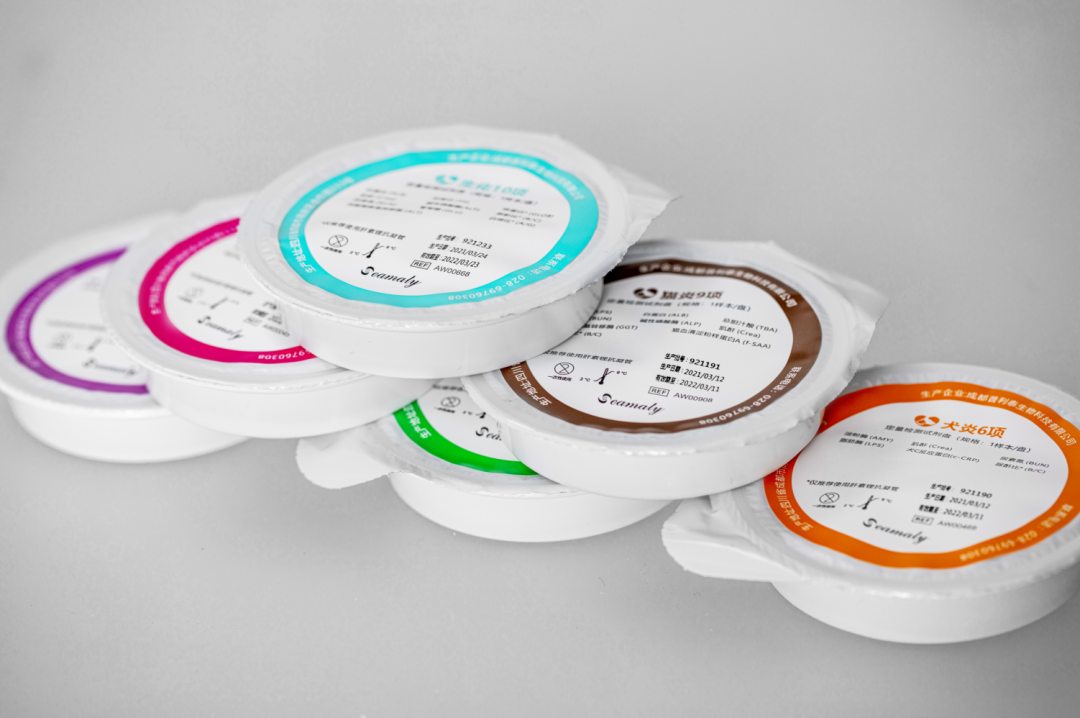According to the report, a total of 88 million households in Europe currently have at least one pet, accounting for about 38% of all households, an increase of 3 million households from 2019. According to the EU average of 2.3 people per household, there are about 202 million people in the European region who have pets.
With more people owning pets, pet health issues are gaining more attention, which has increased the need for pet hospitals and medical equipment.
Compared with traditional large and time-consuming pet diagnostic equipment, Chengdu Seamaty Technology Co., Ltd. has introduced a portable biochemical analyzer - SMT-120V - developed specifically for pet diagnosis.
The SMT-120V is a fully automatic biochemical analyzer that can test routine biochemistry (nearly 30 items in a single test), coagulation (4 items), blood gas electrolytes (including pH), and some immune items (c-CRP, f-SAA.). The SMT-120V is a truly multifunctional instrument.
The 22-item reagent tray for comprehensive tests was developed exclusively by Chengdu Seamaty Technology Co., Ltd. and enjoys several invention patents. The reagent tray is designed with an exclusive 40-hole, black retaining ring. This reagent tray can bring more convenient and comprehensive biochemical tests for pets.
The comprehensive 22-item reagent tray is very comprehensive, covering a wide range of items such as liver, kidney, pancreas, cardiac muscle, ion, protein and metabolism, etc. The MT-120V biochemical analyzer's accompanying chemical reagent tray is ideal for disease screening and health checkups for pets.

The comprehensive 22 tests are ALB, ALP, ALT, AMY, AST, Ca, CK, Crea, GLU, GGT, LDH, LPS, PHOS, TBA, TB, TC, TG, TP, BUN, GLOB, A/G, B/C.
Compared to the 16-item health check reagent tray, the 22-item comprehensive check reagent tray has the following six additional items:LPS, ALP, TC, GGT, TBA, and LDH.
The following is a description of each of the six new items.
01 LPS
Elevated: acute and chronic pancreatitis, pancreatic fluid stagnation (pancreatic cancer, pancreatic cyst, bile duct cancer, cholelithiasis, papillary cancer, etc.), renal insufficiency, pancreatic injury, perforated peritonitis, pancreatic duct obstruction (stones, opium, codeine, methacholine).
Lowering: advanced pancreatitis, major pancreatic resection
02 ALP
High concentration :
-
1. diseases of the hepatobiliary system (gallstones, parasitic gallbladder obstruction)
-
2. Induced by the use of drugs such as corticosteroids.
-
3. enhanced osteoblast activity due to bone marrow disease.
-
4. malignant tumors.
-
5. acute toxic liver injury, etc.
-
6. anticonvulsant drugs (phenobarbital, epilepsy anserine).
-
7. biliary depression liver disease, cholesterol overload, bone development, liver disease, pancreatitis, kidney disease.
Low concentration :
-
1. hypothyroidism.
-
2. Zinc deficiency.
03 TC
High:
-
1. hypothyroidism, seen as hyperlipidemia.
-
2. diabetes mellitus, seen as mild hyperlipidemia.
-
3. nephrotic syndrome.
-
4. acute pancreatitis in dogs.
-
5. feline adipose tissue inflammation.
-
6. canine liver disease with bile obstruction disease, canine nephrotic syndrome.
-
7. bile duct obstruction, adrenal cortical overfunction, acute nephritis.
Low:
-
1. excessive exercise.
-
2. progressive liver disease.
-
3. chronic malnutrition, absorption disorders.
-
4. hyperthyroidism, reduced adrenocortical function, proteinemia of nephrotic syndrome, cirrhotic ascites.
-
5. hepatocellular lesions, diabetes mellitus, anorexia nervosa.
04 GGT
High:
-
1. liver disease.
-
2. bile duct obstruction.
-
3. jaundice.
-
4. acute pancreatitis.
-
5. biliary depression liver disease, feline biliary tract disease (test indicator).
Low:
No special clinical significance.
05 TBA
High:
-
1. markedly elevated in acute hepatitis.
-
2. mildly elevated in chronic hepatitis, such as slow-acting liver, slow-moving liver, etc.
-
3. Hepatic steatosis, fatty liver, liver cancer, etc. may also be elevated.
-
4. Biliary tract diseases, acute and chronic biliary obstruction.
Low:
No special clinical significance.
06 LDH
High:
-
1. young animals.
-
2. tissue necrosis (myocardium, liver, skeletal muscle).
-
3. malignant tumors (especially lymphosarcoma), leukemia, toxoplasmosis, hemolysis (artificial).
-
4. muscle disease or trauma.
Low:
no special clinical significance.
For more information about SMT-120V chemistry analyzer and reagent tray, please contact us at sales@seamaty.com



